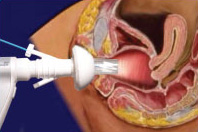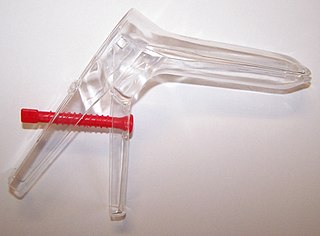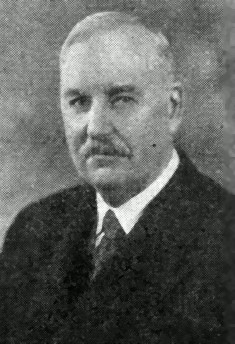Related Research Articles
Abortion is the termination of a pregnancy by removal or expulsion of an embryo or fetus. An abortion that occurs without intervention is known as a miscarriage or "spontaneous abortion"; these occur in approximately 30% to 40% of pregnancies. When deliberate steps are taken to end a pregnancy, it is called an induced abortion, or less frequently "induced miscarriage". The unmodified word abortion generally refers to an induced abortion. The reasons why women have abortions are diverse and vary across the world. Reasons include maternal health, an inability to afford a child, domestic violence, lack of support, feeling they are too young, wishing to complete education or advance a career, and not being able or willing to raise a child conceived as a result of rape or incest.

Caesarean section, also known as C-section or caesarean delivery, is the surgical procedure by which one or more babies are delivered through an incision in the mother's abdomen, often performed because vaginal delivery would put the baby or mother at risk. Reasons for the operation include obstructed labor, twin pregnancy, high blood pressure in the mother, breech birth, and problems with the placenta or umbilical cord. A caesarean delivery may be performed based upon the shape of the mother's pelvis or history of a previous C-section. A trial of vaginal birth after C-section may be possible. The World Health Organization recommends that caesarean section be performed only when medically necessary. Most C-sections are performed without a medical reason, upon request by someone, usually the mother.

Obstetrics and Gynaecology is the medical specialty that encompasses the two subspecialties of obstetrics and gynecology.
Obstetrics is the field of study concentrated on pregnancy, childbirth and the postpartum period. As a medical specialty, obstetrics is combined with gynecology under the discipline known as obstetrics and gynecology (OB/GYN), which is a surgical field.

Gynaecology or gynecology is the area of medicine that involves the treatment of women's diseases, especially those of the reproductive organs. It is often paired with the field of obstetrics, forming the combined area of obstetrics and gynecology (OB-GYN).

A speculum is a medical tool for investigating body orifices, with a form dependent on the orifice for which it is designed. In old texts, the speculum may also be referred to as a diopter or dioptra. Like an endoscope, a speculum allows a view inside the body; endoscopes, however, tend to have optics while a speculum is intended for direct vision.

Misoprostol is a synthetic prostaglandin medication used to prevent and treat stomach and duodenal ulcers, induce labor, cause an abortion, and treat postpartum bleeding due to poor contraction of the uterus. It is taken by mouth when used to prevent gastric ulcers in people taking NSAIDs. For abortions it is used by itself and with mifepristone or methotrexate. By itself, effectiveness for abortion is between 66% and 90%. For labor induction or abortion, it is taken by mouth, dissolved in the mouth, or placed in the vagina. For postpartum bleeding it may also be used rectally.

Obstetric ultrasonography, or prenatal ultrasound, is the use of medical ultrasonography in pregnancy, in which sound waves are used to create real-time visual images of the developing embryo or fetus in the uterus (womb). The procedure is a standard part of prenatal care in many countries, as it can provide a variety of information about the health of the mother, the timing and progress of the pregnancy, and the health and development of the embryo or fetus.

William Smellie was a Scottish obstetrician and medical instructor who practiced and taught primarily in London. One of the first prominent male midwives in Britain, he designed an improved version of the obstetrical forceps, established safer delivery practices, and through his teaching and writing helped make obstetrics more scientifically based. He is often called the "father of British midwifery".

An osteotome is an instrument used for cutting or preparing bone. Osteotomes are similar to a chisel but bevelled on both sides. They are used today in plastic surgery, orthopedic surgery and dental implantation.
A cranioclast is surgical instrument akin to a strong forceps. It was once used to crush and then extract the skull of a fetus so as to facilitate delivery in cases of obstructed labour.

The University of Medicine 2, Yangon is a university of medicine, located in North Okkalapa, Yangon, Myanmar. The university offers M.B., B.S. degrees and graduate degrees in medical science. The university is one of the most selective in the country, and accepts approximately 300 students annually based solely on their University Entrance Examination scores.

Obstetrical forceps are a medical instrument used in childbirth. Their use can serve as an alternative to the ventouse method.

The Sloane Hospital for Women is the obstetrics and gynecology service within NewYork-Presbyterian Hospital and the Department of Obstetrics and Gynecology of the Columbia University College of Physicians and Surgeons (P&S) in New York City. It was founded in 1886 with Columbia P&S as a training and treatment center for obstetrics. It has provided over 100 years of obstetrical care. The hospital is located within Morgan Stanley Children's Hospital.

The Dittrick Museum of Medical History is part of the Dittrick Medical History Center of the College of Arts and Sciences of Case Western Reserve University, Cleveland, Ohio. The Dittrick Medical History Center is dedicated to the study of the history of medicine through a collection of rare books, museum artifacts, archives, and images. The museum was established in 1898 by the Cleveland Medical Library Association and today functions as an interdisciplinary study center. It is housed in the Allen Memorial Medical Library on the campus of Case Western Reserve University in Cleveland, Ohio's University Circle.

Sir Kedarnath Das CIE, MD (1867–1936) was a prominent obstetrician and medical educator of India from Calcutta.
Magnesium salts are available as a medication in a number of formulations. They are used to treat magnesium deficiency, low blood magnesium, eclampsia, and several other conditions. Magnesium is important to health.
Obstetric anesthesia or obstetric anesthesiology, also known as ob-gyn anesthesia or ob-gyn anesthesiology, is a sub-specialty of anesthesiology that provides peripartum pain relief (analgesia) for labor and anesthesia for cesarean deliveries ('C-sections').

Herbert Ritchie Spencer was professor of obstetrics at University College London.
Surgical Instruments and Health Museum is a medical museum in Samsun, Turkey exhibiting historical surgical instruments and medical objects. Housed in a former locomotive depot, it was founded by the city of Samsun in cooperation with many local institutions at the end of 2021.
References
- ↑ W.L. Richardson (January 3, 1878). "Recent progress in obstetrics" The Boston Medical and Surgical Journal 10–3.
- ↑ Hicks JB (1867). "The Cephalotribe". Br Med J . 2 (355): 337–338. doi:10.1136/bmj.2.355.337-a. PMC 2310674 . PMID 20744902.